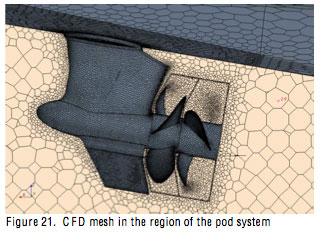Propeller Guard CFD: Oliver Lee Thesis
Propeller Guard Design: An Investigation Using CFD. Oliver Lee. University of Sydney (Australia). November 2011.
We are thrilled to welcome this Computational Fluid Dynamics (CFD) analysis of propeller guards into the library of academic research studies on propeller guards by college students around the world. We also proud to have been a small part of it as it developed. A huge thanks to Oliver Lee for his efforts, to Dr. Steve Armfield his supervisor, to Julian Todd (an Australian propeller safety advocate who assisted with the project), and to the University of Sydney for all their support.We first heard from Oliver Lee back in late March 2011 as he was getting underway on his Senior Thesis and were able to point him to some information and other studies he found helpful.
Since then he took on a broad swath of propeller guard topics in addition to performing the CFD analysis:
- Surveyed the types of propeller guards and other propeller safety devices available
- Investigated the history of propeller guards and the debate surrounding their use
- Investigated the accident frequency of propeller guards
- Investigated the relative costs of propeller guard designs
- Investigated the Australian Safety Propeller and how it fits within this arena
- Developed a propeller guard rating system based on the protection provided
- Developed the model and the equations for the CFD analysis
You can download the full pdf document from the link below the thesis.
[gview file=”https://www.propellersafety.com/wordpress/wp-content/uploads/propeller-guard-CFD-lee-thesis.pdf”]
Oliver Lee did a great job of laying some significant groundwork in this field. Like many students, we suspect he bit off a bit larger/broader topic than he was able to fully get to the bottom of, but by doing so he made it much easier for those students who elect to follow his pioneering work in this field. They can just say something like:
“Oliver Lee documented that propeller guards are available in many configurations and are being investigated as means to prevent or mitigate propeller accidents. Lee also demonstrated CFD is a tool that holds promise in its ability to model flows around propeller guards and predict their efficiencies while the widespread use of guards and their utility is still being debated. Therefore, my research will build upon Lee’s and explore how CFD can be used to model the efficiency of propeller guards and provide design insights to propeller guard designers.”
Then they can takeoff and focus their energies solely on the Computational Fluid Dynamics (CFD) modeling of propeller guards.
We do have a few comments to Oliver Lee (which we have already passed along to him) and to those who will hopefully follow him and build upon his CFD work on propeller guards:
- I realize things have to start pretty basic, and then build up from there in CFD. I suspect the use of an actuator disk vs. a propeller will create significant differences in part due to the pulsating flow of propellers. The CFD models we see of propeller flows show those pulsations exist downstream a while and would certainly effect the “lid”.
- I thought it was interesting your CFD model was unable to model the flow though the cylindrical mesh guard (mesh for a ring and mesh for an end cap/lid) without exceeding your computing power time limits. It was also unable to model a solid ring with a mesh end cap (lid).
- If you or anybody tries this again, please let us know, we may be able to get you some computer time on a faster machine. We “sort of” have contacts with a couple bigger machines, or you might be able to jump on some systems that bundle a bunch of PCs together locally, or on a network like the one SETI was using at Boic. Plus we could put out a plea for some help here that might find somebody willing to donate some computer time too.
We recognize there is still a long ways to go, but these things all start as a series of steps. As researchers are able to gain a better understanding of the models and verify them, they will be able to add more elements (propeller model, include the drive, include the boat hull, etc.). We hope to one day see these models include people in the water as well. As we mentioned elsewhere, there are existing models for underwater people that can be adapted to these uses.
Plus we have some miscellaneous comments:
- While we may not always agree with the ratings of guard types by others, or their assessment of certain situations, its great to see others coming into the field of boat propeller safety with a fresh look and expressing their ideas. We can learn much from new people that do not come in with strong biases one way or the other on the issues that have been debated for decades.
- I found it interesting that Oliver Lee referred to the end cap, shield, or rear screen present on some propeller guards as a “lid”. I think that is a better term
than the others we have previously heard. It takes me to the flip up lid of our kitchen trash can. (he probably calls it a kitchen bin).
In closing, another big thanks to Oliver Lee and his pioneering work on applying CFD to boat propeller guards.
We look forward to other students at Sydney University and other places around the world continuing the work began by Oliver Lee. If you are interested in doing that, please contact us.
